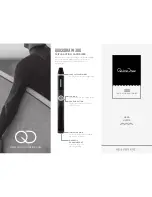
WT.025.000.001.UA.IM.0614
PAGE 13
CHLORINE HANDLING MANUAL
EVOQUA
W3T98244
the discharge of chlorine through any leaks.
WARNING: IT IS ESSENTIAL THAT PROPER BREATH-
ING APPARATUS BE AVAILABLE BEFORE CHLORINE IS
ADMITTED TO ANY PIPING SYSTEM OR EQUIPMENT.
THIS APPARATUS WILL BE DISCUSSED FURTHER UNDER
“PERSONNEL SAFETY”.
Chlorine leaks are best located using a dauber moistened
with commercial 26° Baume’ aqueous ammonia (house-
hold ammonia is not strong enough) . A white cloud will be
formed at the site of any leak. A plastic squeeze bottle that
directs ammonia vapor, not liquid, at the joint being tested
may also be used.
When a leak is detected, the system must be depressurized
before corrective action is taken. The best method of de-
pressurizing the system is through one of the chlorinators.
At least one chlorinator must be readily available for this
purpose before testing with chlorine begins.
5 PERSONNEL SAFETY
5.1 GENERAL
Proper consideration of personnel safety begins with the
provision of properly sized and arranged housing so that
operating personnel have adequate room to perform their
duties. It is preferable that any room used for chlorine stor-
age or equipment have two doors that open outward and
that are equipped with panic bars.
Rooms housing chlorination equipment, and chlorine con-
tainers that are “in service” or “in reserve”, should be heated
when the room temperature falls below 50° F. Comfortable
working temperatures of 65° to 75° F are recommended
for the chlorine equipment room. The temperature of the
chlorine container room (if separate) should normally be 5°
to 10° F lower. All common methods of heating are accept-
able, provided that care is taken to prevent overheating of
chlorine containers. Radiators should not be located adjacent
to containers. If space heaters are used, the warm air should
be deflected away from the containers. Outside windows
should be located or screened so that the rays of the sun
do not fall directly on chlorine containers.
Natural ventilation may be adequate for a small chlorinator
installation in a separate building when windows and doors
can provide cross circulation; however, ventilation by means
of a proper type electric fan is always recommended.
In all cases, installations must comply with appropriate
regulations.
5.2 HEALTH HAZARDS
Exposure to a sufficiently high concentration of chlorine
can result in difficulty in breathing and, if prolonged, finally
death through suffocation. Chlorine’s strong pungent odor
may result in detection at levels as low as 1.0 ppm and most
people will detect it by the time the concentration reaches
3.5 ppm. Concentrations of 5 ppm or more are so objection-
able that only those who are unconscious or trapped will
normally remain in the area. Increasing concentrations will
produce eye irritation, coughing, throat irritation, vomiting,
and labored breathing.
Even concentrations below the threshold of smell can result in
minor eye and throat irritation if the exposure is long enough.
Liquid chlorine can cause burns and/or irritation when it is
in contact with the skin or eyes.
Medical attention should be obtained immediately for person-
nel who have sufficient exposure to result in any symptoms
beyond minor irritation. Properly trained and equipped first
aid personnel are usually the first line of defense. While
waiting for their arrival, the exposed individual must be
removed to a safe area and be placed in a comfortable posi-
tion. If breathing has stopped, artificial respiration must be
started immediately. CPR administered by properly trained
personnel is required if the heart has stopped.
If the exposed individual has difficulty breathing, oxygen
should be administered only by those adequately trained
in the procedure and the equipment used.
The proper procedure for emergency treatment of cloth-
ing or skin contaminated by chlorine is to flush the area
with large quantities of water under a shower for at least
15 minutes. While still under the shower, affected clothing
should be removed. No medical treatment or neutralization
of the chlorine should be attempted except as directed by
a physician.
Immediate flushing with tepid water should be administered
if even small quantities of chlorine enter the eye or if the
eye has been exposed to strong concentrations of chlorine.
The eyelids must be parted and thorough flushing continued
for at least 15 minutes. As mentioned previously for skin
exposure, no medical treatment or neutralization should be
attempted except as directed by a physician.
The attending physician may wish to refer to a Material Safety
Data Sheet on chlorine as well as to the Chlorine Institute’s
Chlorine Manual and/or Pamphlet 63, First Aid and Medical
Management of Chlorine Exposures.
Содержание Wallace&Tiernan 50-200 Series
Страница 1: ...Series 50 200 Evaporator For Chlorine BOOK NO WT 050 200 001 UA IM 0814 W3T198237 ...
Страница 2: ...SERIES 50 200 EVAPORATOR FOR CHLORINE BOOK NO WT 050 200 001 UA IM 0814 W3T198237 ...
Страница 15: ...WT 050 200 001 UA IM 0814 50 200 EVAPORATOR FOR CHLORINE 4 EVOQUA W3T98237 ...
Страница 75: ...WT 050 200 001 UA IM 0814 50 200 EVAPORATOR FOR CHLORINE 64 EVOQUA W3T98237 ...
Страница 95: ...CHLORINE HANDLING MANUAL Cl2 BOOK NO WT 025 000 001 UA IM 0614 W3T98244 ...
























